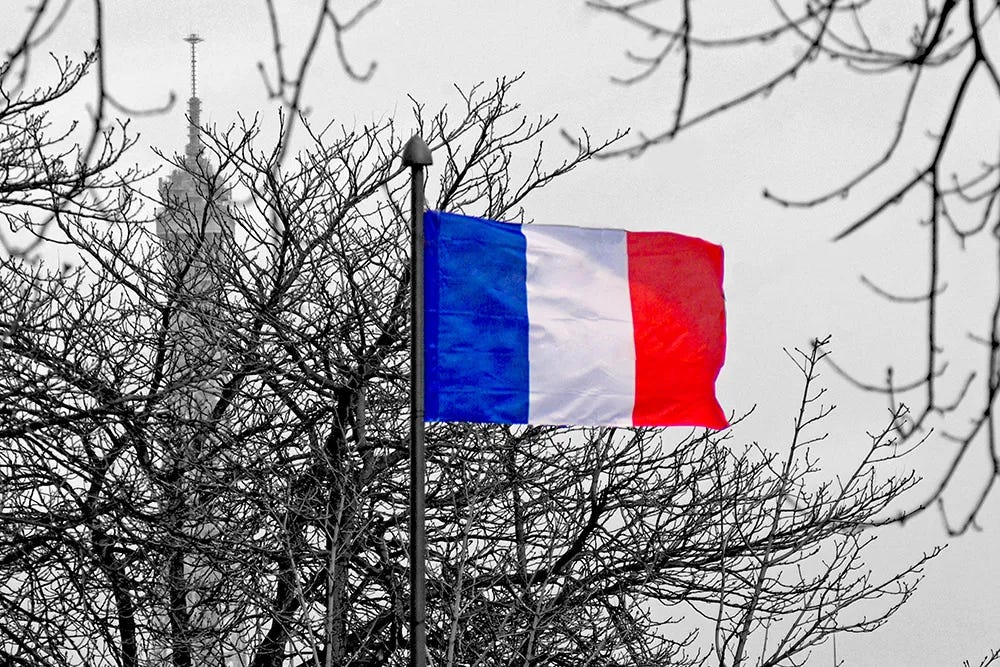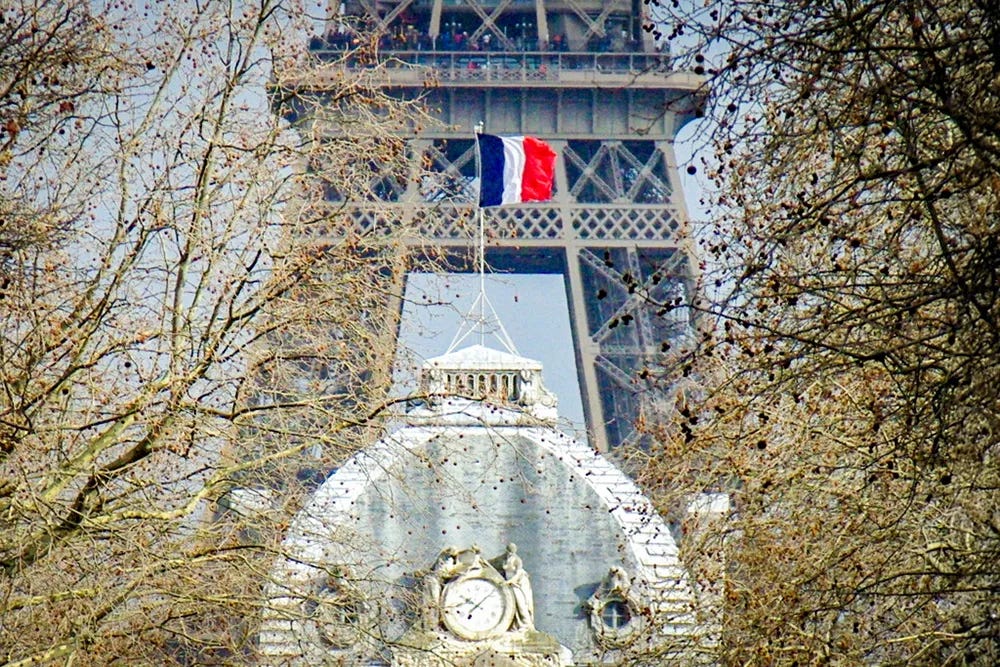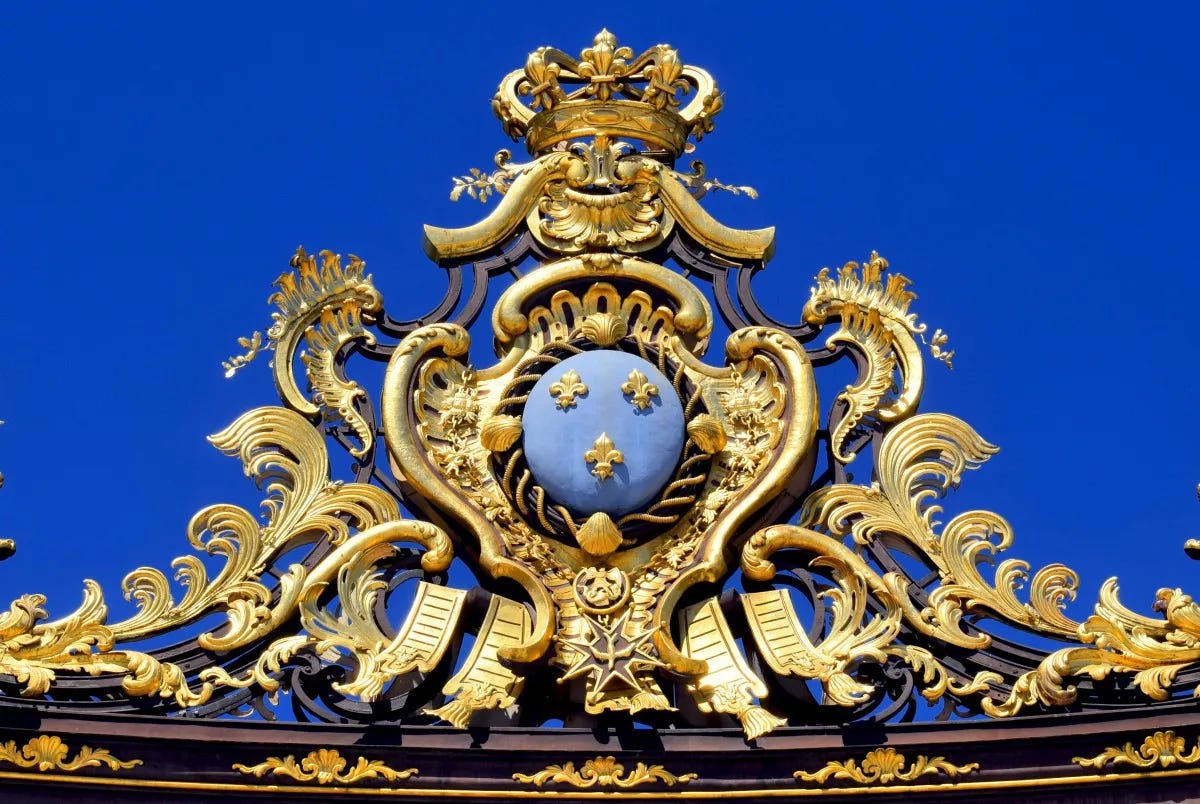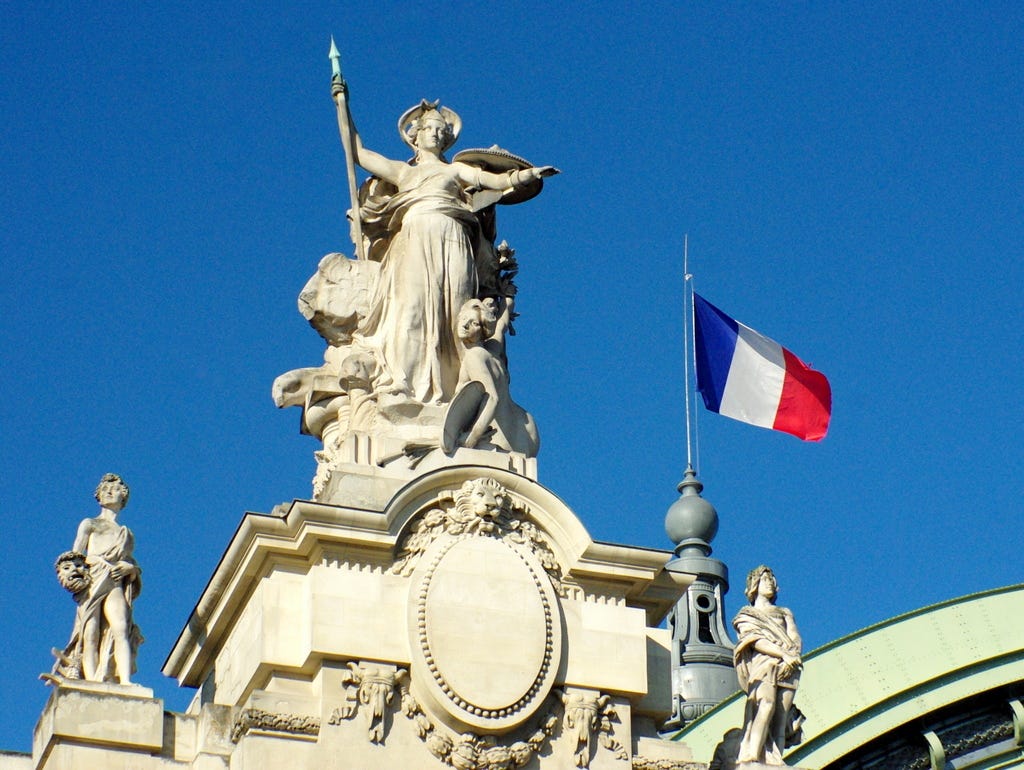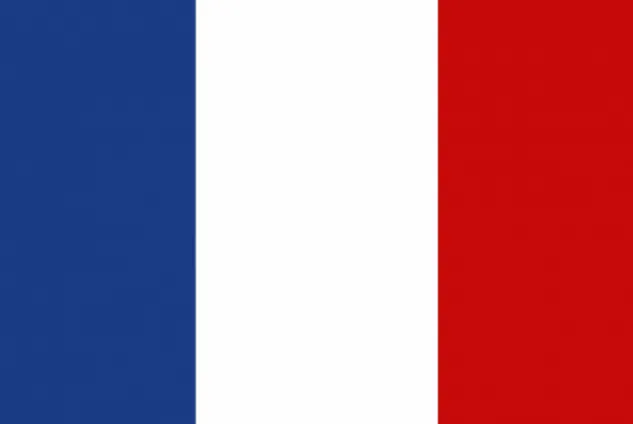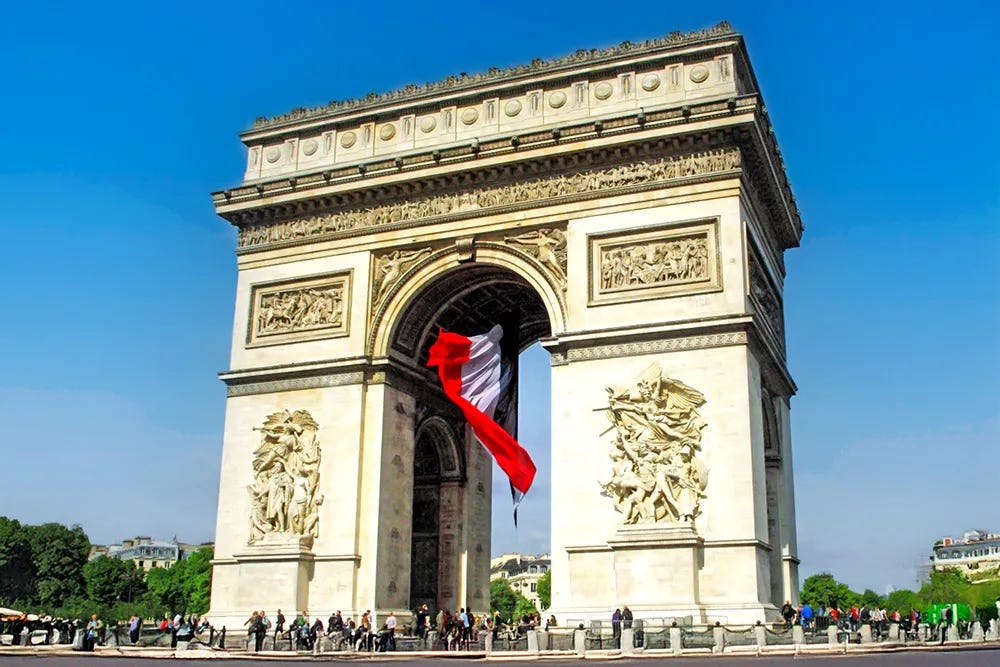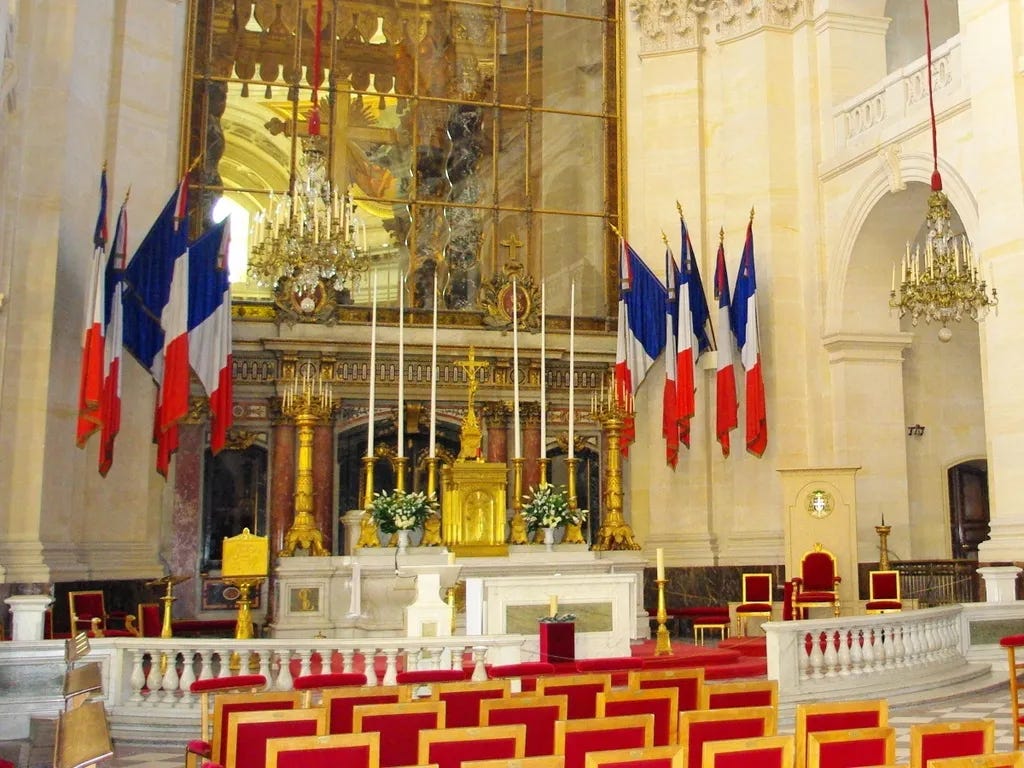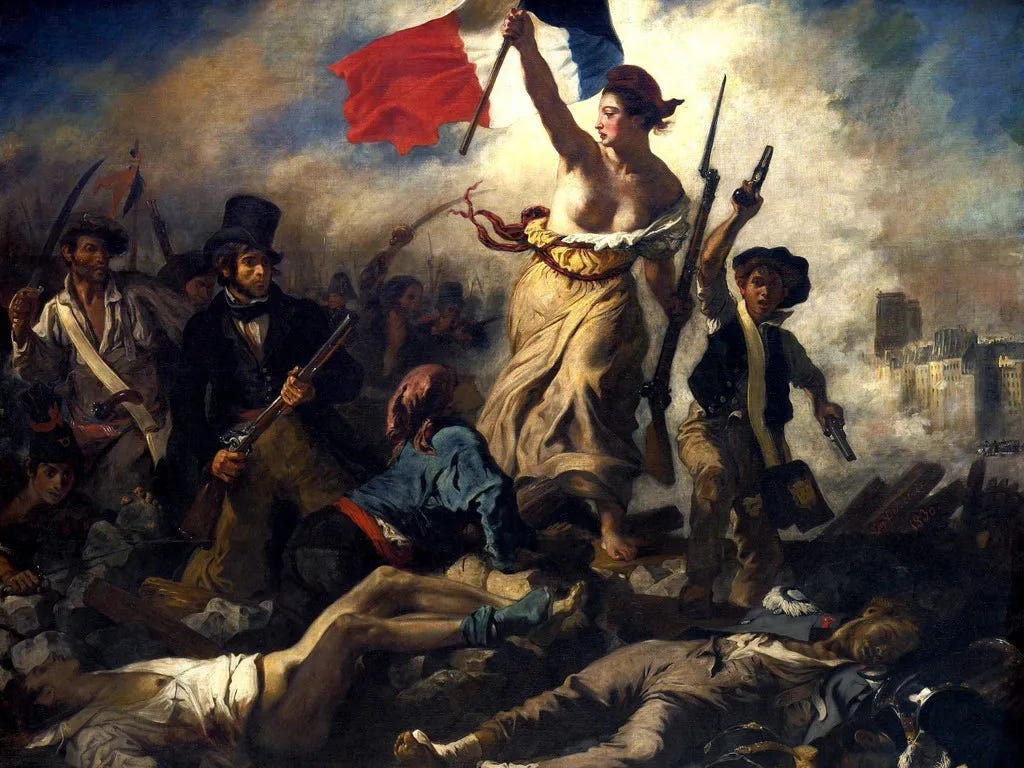The French Flag: Three Colours, a Thousand Stories
Three colours, a thousand meanings — the story behind France’s most visible symbol.
Bonjour!
In this article, I have the pleasure of opening a special series leading up to Bastille Day, exploring the most iconic national symbols of the French Republic — starting with the one that flies highest and most often: the Tricolour.
The French flag isn’t just a flag. It’s a tapestry of history
French flag in Paris. All photos © French Moments unless otherwise noted
You might think a flag is simple.
A few colours, a bit of fabric, something to hang outside a town hall or wave during a football match. But the French flag? The Tricolour? That one is different. It has been soaked in the blood of revolutionaries and paraded by kings. Carried into battle by saints and martyrs, flown by republicans and monarchists alike. It has been banned, burned, reinvented, lightened for diplomacy, darkened for defiance, and occasionally—rather awkwardly—forgotten.
And despite what schoolbooks might suggest, it didn’t simply appear in 1789 like a magic spell cast by liberty. No, the story of the French flag begins much earlier. In a monastery. In a battlefield. In a painter’s studio. In the mind of a draper named Étienne Marcel in the cloak of a bishop named Martin. And possibly—though it sounds absurd—in a cockade mistakenly pinned upside down. It is a flag born of contradiction. Blue for Paris, or the Virgin Mary? White for the king, or the people? Red for martyrdom, or massacre?
The Tricolour is a riddle. And if you follow the threads closely, you’ll find that each colour tells a different tale.
Let’s begin with the ones that came before.
The Tricolour on top of the École Militaire, Paris
Before the Tricolour: Flags of a fractured kingdom
Long before France had a flag, it had banners. Not one, but many.
In medieval France, loyalty wasn’t to a nation. It was to your feudal lord, your bishop, your city, your abbey. And each had its own colours.
The red of the Oriflamme was the battle standard of Saint-Denis, a banner soaked in myth and martyrdom. According to legend, it was first carried by King Dagobert I and later waved above crusader armies. Its red was not symbolic of love, but of divine vengeance.
The white of the royal cornette emerged later, as the colour of military command. By the 17th century, white became the king’s colour—flown from ships, carried into war. When Henri IV rode into battle, he wore a white scarf to be seen by his troops: “Ralliez-vous à mon panache blanc !”.
Blue was more ambiguous. It was the colour of the Capetian kings, said to be inspired by the heavenly cloak of Saint Martin. But it was also the colour of Paris. In 1358, during a popular uprising, the merchant Étienne Marcel stormed the palace and placed his red-and-blue hood on the Dauphin’s head, both symbolic and terrifying.
The fleur-de-lys reigned supreme over these colours, decorating royal shields and banners. But even the lily had rivals.
Joan of Arc’s banner, for example, was white, painted with the image of God between two angels. She claimed it was commanded by Heaven. And who were the kings to argue? If you had lived in 1600, and someone asked you what the flag of France looked like, you’d have had no answer. It depended. The navy flew one thing, the army another. In times of war, banners were less about patriotism and more about recognition—who was with you, who wasn’t, and who was very likely to stab you.
The cockade, the crowd and the king
It began with a leaf.
On 12 July 1789, two days before the Bastille fell, a young journalist named Camille Desmoulins stood atop a table in the Palais-Royal gardens, waving a pistol in one hand and a green leaf in the other. “To arms!” he cried. “Let us take the green cockade, the colour of hope!” The crowd followed. Thousands began pinning green leaves to their hats, coats, and sleeves. It was an exhilarating symbol… for about 24 hours.
Then someone pointed out the awkward truth: green was also the colour of the Count of Artois, the King’s brother and a deeply unpopular figure. No one wanted to march under his colour. By the next day, the cockades were red and blue instead—the colours of Paris. The people’s colours. The revolution’s colours. And then came the white.
The story goes that when King Louis XVI came to Paris on 17 July 1789 to “make peace” with the people, Lafayette himself—or perhaps Mayor Bailly—handed him a cockade with white added to the red and blue. Why white? Because it was the king’s colour. A symbol of national unity. An olive branch. A masterstroke of optics.
Depending on whom you ask, the king accepted it with grace, or reluctance, or mild confusion. One thing is certain: the gesture didn’t save him. But it did give birth to the French Tricolour.
The colours settle (almost)
Red. White. Blue. It seemed simple. But the Revolution wasn’t big on simplicity.
Early revolutionary flags used all sorts of combinations:
horizontal bands, vertical bands,
white in the centre, red in the centre, sometimes even blue,
and orders that went blue-red-white, white-red-blue… anything but consistent.
Even the revolutionary soldiers weren’t quite sure which version to salute. That changed on 15 February 1794, when the National Convention decreed that:
“The national flag shall be composed of the three national colours, arranged in three equal vertical bands: blue near the hoist, white in the centre, red on the fly.”
And just like that, the French flag had its structure. The man tasked with the visual design? Jacques-Louis David. Painter of The Death of Marat, future court artist to Napoleon, and a man who understood better than most the power of symbols. In his hands, art and politics merged. The Tricolour wasn’t just a flag; it was a banner of destiny.
But meaning? That was left vague.
Some said the blue and red were for Paris, while white was for the monarchy. Others claimed the three colours stood for the three estates: blue for the bourgeoisie, white for the clergy, red for the nobility. More poetically: blue was liberty, white was equality, red was fraternity.
And yet others whispered that the colours reflected the Virgin Mary, Saint Michael, and the blood of martyrs.
As with much in France, it depends on who’s talking.
The flag’s disappearance (and return)
The Tricolour didn’t enjoy an unbroken reign. After Napoleon’s defeat at Waterloo in 1815, the restored Bourbon monarchy immediately scrapped it. The white flag came back, pure and pristine, fluttering once more above Versailles. It was as if the Revolution had never happened.
Except, of course, it had.
In July 1830, three days of protests erupted against King Charles X’s increasingly autocratic rule. The people stormed the streets—again—and waved the Tricolour from windows and barricades.
The white flag was torn down. Louis-Philippe, the “Citizen King”, reinstalled the Tricolour as the official flag of France. It’s remained ever since.
Well—mostly.
A flag for all regimes (and none!)
Here’s the twist: the French Tricolour has served monarchs, emperors, and republics alike. It has waved above palaces and prisons, over trenches and schools, at liberation parades and protest marches. But it hasn’t always looked the same.
Under Napoleon I, it was carried by armies across Europe.
Under the Restoration, it disappeared.
Then it came back under Louis-Philippe.
Then again under the Second Republic.
Then the Second Empire.
Then the Third Republic…
France, after all, is nothing if not complicated.
And the flag has adapted.
Take 1976. President Valéry Giscard d’Estaing quietly decided that the flag’s colours were too “brash” for diplomatic protocol. So he ordered a lighter blue and a softer red, closer to the European flag. The difference wasn’t huge, but symbolically, it mattered.
Fast forward to 2020. President Emmanuel Macron, with no press release and no announcement, returned to the deeper, darker blue—restoring the flag’s 19th-century tones. He reportedly wanted a “more solemn” feel. More historical. More… French.
Nobody noticed. Until someone did.
The flag goes to war (and art)
Throughout the 20th century, the Tricolour appeared where it mattered most.
In 1914, French soldiers went to war with cockades on their kepis, often forgetting their blue overcoats made them easy targets.
In 1940, after the armistice, it was the flag of Vichy France… but also the flag of Free France. Two sides. One banner. The Resistance would often modify it—adding a cross of Lorraine, drawing a line through the white.
In 1944, it returned to Paris alongside General de Gaulle, waving from balconies, from tanks, from homemade poles cobbled together in haste and hope.
In peacetime, it took on quieter roles.
Behind the President during televised speeches.
On government buildings and town halls, next to the European stars.
At schools, where children sometimes learn to raise it in the morning and fold it respectfully (although this practice has become really rare nowadays).
Sometimes it appears where it’s least expected—inside Les Invalides, a church.
Normally, flags don’t belong in French churches. But Les Invalides is different: a soldiers’ church. Napoleon sleeps beneath its golden dome. The flag there doesn’t just flutter. It watches.
And in art?
The Tricolour flutters across the canvas of French memory:
in Delacroix’s Liberty Leading the People, brandished by a bare-breasted allegory of revolution;
in Monet’s Rue Montorgueil, where it dances across a street of joy;
in Manet’s Rue Mosnier, more sombre, more fragile, hung in a city still recovering;
in David’s The Distribution of the Eagles, more imperial than national, more Roman than republican.
The flag has always been both—freedom and power, poetry and protocol.
The French flag in Norwich, England
Now for the part most French people don’t know. The oldest surviving Tricolour—arguably the largest ever made—is not in Paris.
It’s in Norwich.
Yes, Norwich, in England.
In February 1800, during the Napoleonic Wars, the British Royal Navy captured the French warship Le Généreux. Onboard was a massive Tricolour. So massive it measured 16 metres by 8.3 metres—roughly the size of a tennis court. The flag was brought back to England and eventually given to the city of Norwich, where it’s been preserved ever since. It’s an odd twist of history. A symbol of revolutionary France, hanging in an English cathedral city, captured by the enemy, yet revered as a relic.
There’s something beautiful about that. Something profoundly French, too.
Conclusion: Three colours, never just one story
The French flag is easy to describe. Blue. White. Red. Three vertical stripes. That’s the surface. But like all things French, the real story lies beneath. Each colour is layered with centuries of symbolism—sacred, royal, rebellious, republican. The flag is born of contradictions.
It unites Paris and the provinces. The king and the people. The Church and the Enlightenment. It was designed to bring together, and yet it also divides. It is, at once, a battlefield standard, a painter’s muse, a child’s drawing, a protester’s shield, and a president’s backdrop.
And whether it flies above a marble palace or a provincial mairie, whether it ripples from a jet in the Bastille Day airshow or hangs, strangely, in Norwich…
…it always says the same thing:
“I am France. In all my beauty, my defiance, my complexity.”
The history of the tricolor is fascinating, isn’t it? Share your opinion and experiences below in the comments section.
Introducing Contributor, Pierre Guernier:
Visit his Contributor Page — Explore more of Pierre’s work


